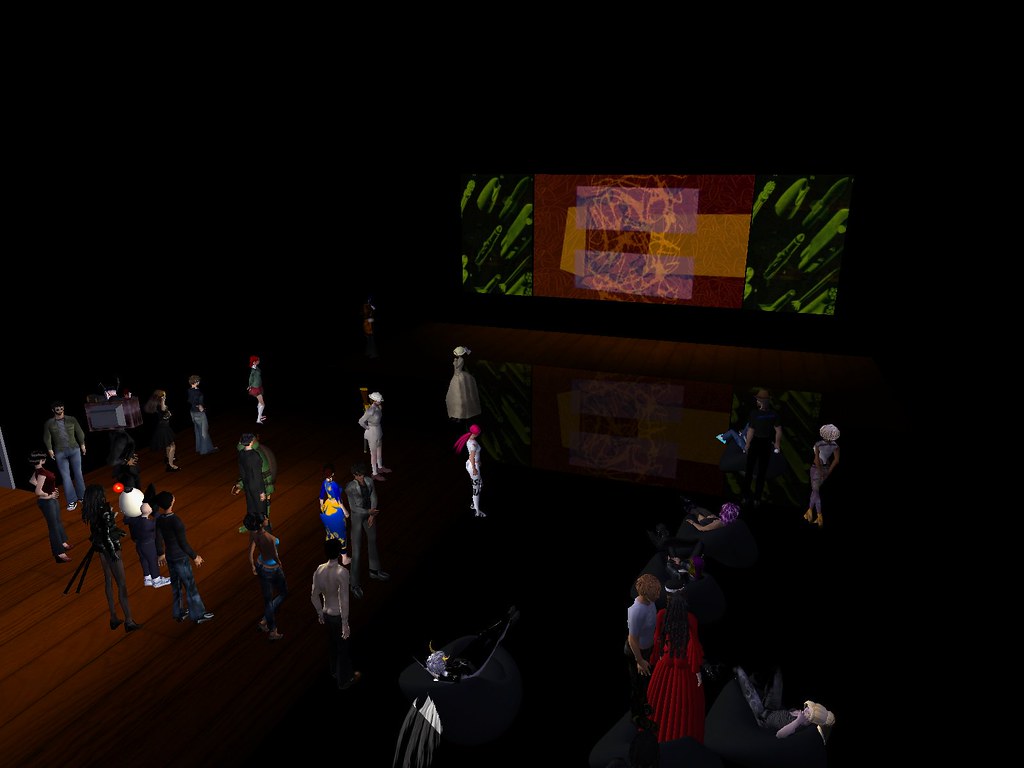Its been a while since I've blogged about the Digital Media courses activities within Second Life. 2nd year project, starting of with an SL based sketchbook.
2nd year project, starting of with an SL based sketchbook.Now a new academic year, and the course moving to new facilities on the Blenhiem Walk Campus, we've decided to jump in deeper with Second Life as part of the course.
Previously, we had rolled out SL as a more tentative venture, using it via Personal Development and Critical Studies - so we could explore Digital Cultures and Emerging Technology. We were very fortunate to also have a project with Penguin, that allow both staff and students to see the Vocational worth of Second Life.
Now the course is into its 2nd Year, we have Specialist Pathway modules in both Moving Image and Interactive Presentation.
For both of these modules, we decided to have a Second Life based brief, they could choose to undertake. The modules started on the 9th Nov.
Interactive PresentationThe Team brief is to create an Art Gallery within Second Life, which can be used by the other students and potential Artist in Residence projects.
The students have to consider curation within a virtual 3D space, the different forms of media that can be shown, how avatars can navigate, explore and engage the work that will be shown, as well as creating signage for the space. Upon this they will create an intergrated CSS template for a Ning based community and Blog.
It is hoped out of this brief, that students can explore and reflect on the differences of Flash or Web based Gallery and information presentation, with this 3D variant. As well as engaging with Social connectivity aspects of both Second Life and web communities like Ning.
Moving ImageThe brief is to create a 2 minute Machinima presentation, to promote the Design for Digital Media course's presence and activity on the Collective's Second Life Island.
Hopefully, through this brief both the creative use of machinima can be explored, but tempered with a corporate sensibility. My gut feeling with more corporate presence within Second Life or similar (PS3 Home or There), there will be a new skill set needed for this convergence industry, and I hope this brief starts to address the portfolio needs of graduating students into this industry.
Also the cross-transferable skills back to video production, still means regardless of it being either traditional video or machinima - the students still has to go through the experience of production management, communicating with cast and crew & editing of footage.
---
With the 1st Years, we've had the opportunity of creating a new 10 credit module called 'Digital Cultures and Technologies', a half practical and theoretical module.
This has given us an opportunity to have a more course wide engagement within Second Life. The project set is called 2020, where we ask the students to design a poster to communicate what they speculate could be future digital ( or other ) experiences, commodities or technologies.
These poster will then also uploaded into Second Life, as part of a display - in the new art gallery the 2nd year's are building.
As part of the module, we've had a seminar on Avatars, which allowed practical play via Second Life.
---
All of these projects will run up till Christmas, which we'll hopefully make open to the public. ( though actually the islands always open to the public, so you can pop by and see work in progress - so excuse the clutter - we're a sandbox, not a polished marketing tool.)
Some of the activity that's been blogged by the students...
http://parkinsonliam.blogspot.com/2007/11/second-life-galleries.htmlhttp://fionnualamurphy.blogspot.com/2007/11/new-shiny-work-area.htmlAs a team, Liam and Fio, have initially created a 3D sketchbook to house both there research and idea development, and a place to try out building prototypes.
( which actually reminds me, I get a few IM's saying that there's seems to be little happening on our island... actually a lot happens its just tends to be up at 500 ms )here's some posts from the 1st years, after playing with avatar creation for an afternoon.
http://markscrit.blogspot.com/2007/10/second-life.htmlhttp://myworldmylifemytime.blogspot.com/2007/10/second-life.htmlhttp://rockbigdave.blogspot.com/2007/09/second-life-at-uni-we-work-d.htmlhttp://digitalbreak.blogspot.com/2007/10/second-life.htmlIt's also sparked some critical response,
http://critwall.blogspot.com/2007/09/scary-life.html

























